|
 Tympanella galanthina Tympanella galanthina
SynonymsAgaricus galanthinus
Naucoria galanthina
BiostatusPresent in region - Indigenous. Endemic
Images (click to enlarge)
Caption: 122-Naucoria galanthina: a. spores. | 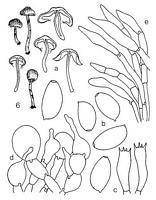
Caption: Tympanella galanthina (C. & M.) Hk.: a. carpophores (nat size) b spores (2000 x). c. basidia
(1000 x). d. cheilocystidia (1000 x). e. cuticle (500 x). | 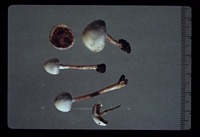
Caption: C-3409
Owner: Herb. PDD | 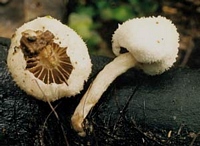
Caption: Tympanella galanthina
Owner: Kaimai Bush | 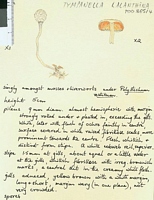
Caption: Watercolour
Owner: G.M. Taylor | 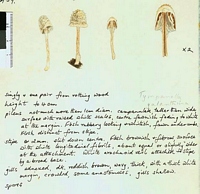
Caption: Watercolour
Owner: G.M. Taylor | 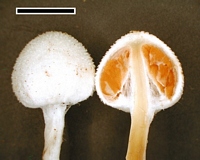
Caption: scale=5mm
Owner: J.A. Cooper | 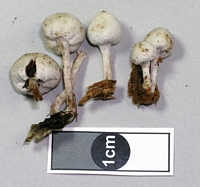
Owner: J.A. Cooper | 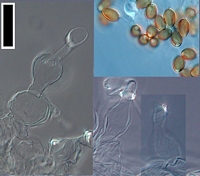
Caption: scale=20um. Spores and cheilocystidia
Owner: J.A. Cooper | 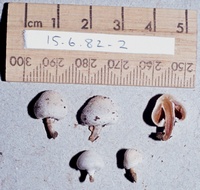
Caption: ZT1655, 15.6.82.2
Owner: E. Horak: © Creative Commons Attribution-Noncommercial 3.0 New Zealand | 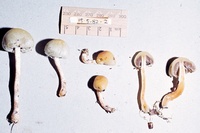
Caption: ZT1967, 15.5.82-2
Owner: E. Horak: © Creative Commons Attribution-Noncommercial 3.0 New Zealand | 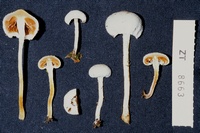
Caption: ZT8663
Owner: E. Horak: © Creative Commons Attribution-Noncommercial 3.0 New Zealand | 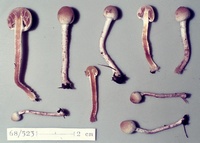
Caption: ZT68-523
Owner: E. Horak: © Creative Commons Attribution-Noncommercial 3.0 New Zealand |
Article: Horak, E. (1971). Contributions to the knowledge of the Agaricales s.l. (Fungi) of New Zealand. New Zealand Journal of Botany 9(3): 463-493 (http://www.rsnz.org/publish/abstracts.php).
Description: Pileus 7-30 mm diam., globose when young,
secotioid, later becoming convex or even campanulate but margin always strongly
incurved: clay, buff, cream or whitish coloured; densely covered by small scales
or squamules, conspicuous white fibrillose veil remnants (especially on young
fruiting bodies) towards the margin, dry, non striate. Lamellae always distinctly
lamellate, never lacunose or anastomosing, adnate or adnexed, occasionally subdecurrent:
rust brown or cinnamon brown, with floccose, with coloured edge. Stipe 10-40
x 1.5-5 mm, cylindrical, not attenuated near the apex (columella absent), concolorous
with pileus; densely covered by white fibrils from the veil, ring or permanent
cortina absent; dry, fistulose, single. Context brownish, watery. No smell or
taste.
Spores 10.5-13.5 x 6.5-8 µm, elliptical,
smooth, thick-walled, in KOH reddish-brown, neither amyloid nor dextrinoid,
with distinct germ pore. Basidia 27-36 x 8-11 µm., 4-spored. Cheilocystidia
15-45 x 12-25 µm, clavate or lageniform, membrane thin-walled, hyaline, forming
a sterile zone at the edge. Cuticle a trichoderm composed of cylindrical or
fusoid hyphae (5-20 µm diam.) with suberect tips, membrane thin-walled, not
gelatinised, pigment not visible, clamp connections rarely absent.
Habitat: On the ground in litter (occasionally on
rotten wood) in forests. New Zealand.
Notes: Although the type collection at Kew is in
poor condition, there can be no doubt that it represents a specimen of this
fungus commonly found in the forests of New Zealand. In many instances, carpophores
can be observed in which the pileus does not open and the lamellae are not exposed.
In old and weathered specimens in which a convex or even campanulate pileus
frequently occurs, rust brown gills are clearly visible. The deep colour of
the lamellae does not change and can still be seen in the type material collected
some 80 years ago.
From the microscopical point of view the
genus Tympanella could be compared with Galeropsis Velenovsky
1930. The macroscopical characters however are strikingly different. Tympanella
never grows in xerothermic localities like Galeropsis, but prefers wetter
conditions in rain forests of New Zealand.
Cunningham identified a collection of this
fungus (PDD 6389) as Secotium leucocephalum Massee, but it seems that
the spores were not thoroughly investigated. Because of the elliptical, warted,
rust brown spores, the type of S. leucocephalum represents a well established
species of the genus Thaxterogaster Singer (T. leucocephalum (Massee)
Singer and Smith).
Article: Cooke, M.C. (1890). New Zealand fungi. Grevillea 19(89): 1-4.
Notes: Allied to Agaricus nasutus, Kalch.
Article: Horak, E. (1971). A contribution towards the revision of the Agaricales (Fungi) from New Zealand. New Zealand Journal of Botany 9(3): 403-462 (http://www.rsnz.org/publish/abstracts.php).
Notes: Fig. 11 The microscopical characters of this collection (BERGGREN 142)
show some affinities to those of a distinct secotiaceous genus as yet unpublished,
endemic to New Zealand. To my knowledge, this taxon is distributed throughout
the forests of New Zealand.
|